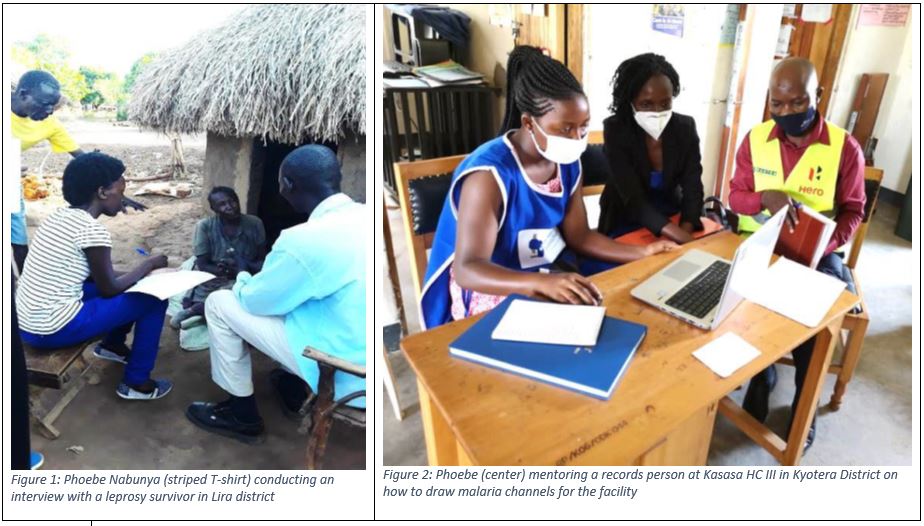 |
Phoebe Nabunya
|
ABOUT THE FELLOWPhoebe Nabunya is an epidemiologist with a special interest in disease outbreak investigations. She holds a Master‟s Degree in Public Health from Makerere University, School Of Public Health and has a background in Human Nutrition. Achievements at the Host SiteThe fellow led a malaria outbreak investigation and response in Kyotera district in 2019 where she was in charge a team of epidemiologists and entomologists. The team conducted line listing from the health facility, environmental assessments, and community assessments to determine the factors associated with the observed increase in cases.
Fellowship program specific achievementsDescriptive analysis Outbreak investigations
Co-Investigator
HIV project
Quality Improvement
Scientific writing
Newspaper articles
Written Manuscripts
Conference presentations
Summary of Epidemiological Study: Title: Spatial distribution of cases in Bugweri district, during a malaria outbreak June 2020 Background: Bugweri District was one of the 34 districts reporting a malaria outbreak in 2020. The outbreak, which started in January 2020, persisted for over 5 months with Buyanga sub-county being the most affected. Buyanga reported the highest increase in cases between January–June 2020, having 32,663 cases compared with 20,000 in the same time frame in 2019. Investigations into the previous malaria outbreaks in the country have been linked to environmental risk factors such as rainfall and presence of breeding sites around households created by nature or human activity. However, the spatial distribution of these cases in relation to known environmental risk factors for malaria has not been done. This study aimed to investigate the malaria outbreak in Buyanga to assess the magnitude and the associated factors using a case control study as well as identify the hotspots for malaria transmission during the outbreak using a Bayesian model to document the spatial distribution of malaria cases in Buyanga Sub-county, Bugweri District. The identification of malaria transmission hotspots through the useof spatial statistics is important to guide the targeting of interventions as residual malaria transmission is likely to persist in hotspots even after overall reduction of malaria in an area. Methods: We developed a line list of malaria cases reported in the sub-county from the health facility data. We then took a random sample of these cases and took the Geographic Positioning System coordinates of their residence. We also conducted a case control study to study the associations between identified exposures and disease status for a sample of the cases. This was done by selecting a proportion of the cases and interviewing them using a structured questionnaire with a proportion of the cases to collect information on their demographic and malaria risk factors for malaria transmission. We conducted matched pair analysis to measure the association between exposure variables and disease status. Results: Similar to other malaria outbreaks in the country, we found that females and children under 5 years had higher attack rates compared to males and older persons. The factors associated with the outbreak were living in close proximity to swamps, living near road ditches and using damaged nets. The fine-scale spatial maps were created to visualize the risk distribution of malaria in Buyanga sub-county at a resolution of 250m by 250m showed that most cases were concentrated in urban areas and along the roads which were being worked on since the end of 2019. Conclusion: There was increased transmission of malaria in Buyanga sub-county between January and June, 2020, likely propagated by the presence of favorable breeding sites near people‟s homes created by the road construction activities coupled with use of torn mosquito nets that promoted exposure. We recommended use of larvicides to control mosquito breeding from identified breeding sites created by human activities such as road construction. Key lessons learnt during the fellowship
|
|
Sign in
Sign in
Recover your password.
A password will be e-mailed to you.

